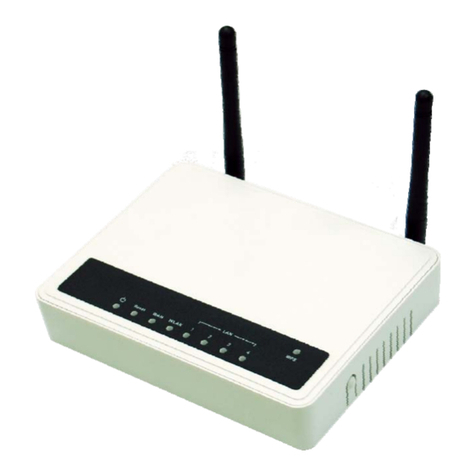
CPE Quick Start Guide
5
h. Enter the ESSID you have gathered from
Step 2. Do not click on the "APPLY"
button now.
i. Click on the tab labeled "IP Address".
j. If you would like to enable the internal
router, select "IP Router" in the TCP/IP
mode selection box and continue to the
next step.
Otherwise choose "Bridge Only" and
perform the following two sub-steps:
i. Enter the IP Address information
from Step 2, or choose to use
DHCP to automatically obtain IP
address, netmask and gateway
information from a DHCP server
by clicking on the "DHCP status"
radio button.
ii. Skip the steps below by
continuing onto Step “v”.
k. Configure the router's WAN port using
information from Step 2 by clicking on one
of the following two radio buttons:
i. WAN on WLA (WLAN)
ii. WAN on Eth (Ethernet)
l. Click on the "SETUP” button just ABOVE
the radio buttons in Step “l” (above) to
setup the WAN port.
m. A new window pops up over the current
window. Click on the "Manual" radio
button to manually configure the WAN
port's IP address, netmask, and gateway.
Or click on the "DHCP" radio button to
automatically assign IP address, netmask,
and gateway information from a DHCP
server.
n. If Network Address Translation (NAT) is
required (i.e., private LAN) place a check
mark next to "NAT (IP Sharing) through
this port".
o. Click on the "Close" button to close this
pop-up window.
p. You are now returned to the original IP
Address tab window. Click on the "SETUP"
button BELOW the WAN port radio
buttons (WAN on WLA, WAN on ETH) to
setup the LAN port.
q. A new windows pops over the current
windows. Enter the Router's LAN port IP
Address and netmask.
r. If you would like to use the built-in DHCP
server to centrally assign IP resources to
PCs on the private LAN, place a check
mark next to "Enable DHCP server".
s. Enter the Start and End IP address for the
DHCP server to assign to DHCP clients
on the private LAN.
t. Enter netmask, gateway, DNS and WINS
server information for the DHCP server to
assign, or click on the radio buttons under
"Use DHCP Wizard" to automatically
obtain this information from the WAN port.
u. Click on the "Close" button to close this
pop-up window.
v. Click on the tab labeled "WEP".
w. The
WEP screen is now displayed.
x. If WEP is required, enter WEP key from
information gathered in Step 2.
y. The product is now fully configured. Click
the "Apply" button. The software will
prompt you that the product will reset to
apply the changes. Click on the "YES"
button to reset the product. Click on the
“LOGOFF” icon to exit the software.
7. Mount Product And Align Internal Antenna.
Warning: As a wireless communication device, the
product has been designed to radiate microwave
(2.4GHz) energy and should only be installed by
qualified professionals. Observe all safety
instructions when performing installation,
specifically, to reduce potential long-term health
hazard, do not stand in front (or within the beam-
width) of the product when it is operating, or position
the product so as to allow exposure of microwave
energy toward human body.
a. Unplug the product from the Power
Injector. Select a suitable outdoor location
to mount the product. Install an antenna
mast as per instruction furnished with
mast and in accordance with National
Electrical Code requirements*
* Note: Be sure the product is grounded so as
to provide some protection against voltage
and built-up static charge. Section 810 of the
National Electrical Code (NEC), ANSI/NFPA
No. 70-1990, provides information with
respect to proper grounding of the mast and
supporting structure, grounding of the lead-in
wire to an antenna-discharge unit, size of
grounding conductors, location of antenna-
discharge unit, connection to ground
electrodes, and requirements for the
grounding electrode.
b. Mount the product by following the
instructions in the section “Using the
Mounting Hardware” (see next section
below). Do not completely tighten the
mounting clamps at this time.
c. Align the product’s internal antenna by
pointing the product directly at the Access


























